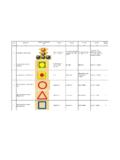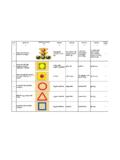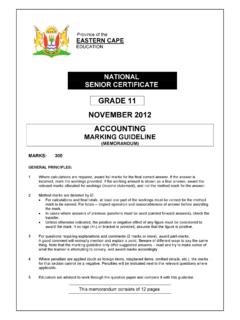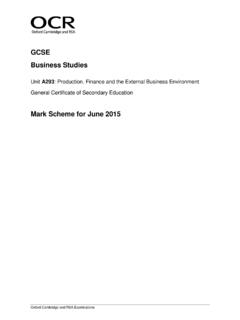Transcription of GCE Physics B (Advancing Physics) - ocr.org.uk
1 Oxford Cambridge and RSA Examinations GCE Physics B (Advancing Physics ) Unit G491: Physics in Action Advanced Subsidiary GCE Mark Scheme for June 2014 OCR (Oxford Cambridge and RSA) is a leading UK awarding body, providing a wide range of qualifications to meet the needs of candidates of all ages and abilities. OCR qualifications include AS/A Levels, Diplomas, GCSEs, Cambridge Nationals, Cambridge Technicals, Functional Skills, Key Skills, Entry Level qualifications, NVQs and vocational qualifications in areas such as IT, business, languages, teaching/training, administration and secretarial skills. It is also responsible for developing new specifications to meet national requirements and the needs of students and teachers.
2 OCR is a not-for-profit organisation; any surplus made is invested back into the establishment to help towards the development of qualifications and support, which keep pace with the changing needs of today s society. This mark scheme is published as an aid to teachers and students, to indicate the requirements of the examination. It shows the basis on which marks were awarded by examiners. It does not indicate the details of the discussions which took place at an examiners meeting before marking commenced. All examiners are instructed that alternative correct answers and unexpected approaches in candidates scripts must be given marks that fairly reflect the relevant knowledge and skills demonstrated. Mark schemes should be read in conjunction with the published question papers and the report on the examination.
3 OCR will not enter into any discussion or correspondence in connection with this mark scheme. OCR 2014G491 Mark Scheme June 2014 1 1. These are the annotations, (including abbreviations), including those used in scoris, which are used when marking Annotation Meaning Blank Page this annotation must be used on all blank pages within an answer booklet (structured or unstructured) and on each page of an additional object where there is no candidate response. Benefit of doubt given Contradiction Incorrect response Error carried forward Follow through Not answered question Benefit of doubt not given Power of 10 error Omission mark Rounding error Error in number of significant figures Correct response Arithmetic error Wrong Physics or equation G491 Mark Scheme June 2014 2 2.
4 Abbreviations, annotations and conventions used in the detailed Mark Scheme (to include abbreviations and subject-specific conventions). Annotation Meaning / alternative and acceptable answers for the same marking point (1) Separates marking points reject answers which are not worthy of credit not answers which are not worthy of credit IGNORE Statements which are irrelevant ALLOW answers that can be accepted ( ) Words which are not essential to gain credit __ Underlined words must be present in answer to score a mark ecf Error carried forward AW Alternative wording ORA Or reverse argument 3. The following questions should be annotated with ticks to show where marks have been awarded in the body of the text: 2a, 3c, 7a, 8aii, 8bii, 8biii, 9ai, 9aiii, 9b, 9c, 10a, 10ci, 10cii, 10ciii 4.
5 Please ensure that rounding errors RE and significant figure errors SF are only penalised a maximum once for each candidate. Places where these should be looked for will usually be indicated in the mark-scheme. G491 Mark Scheme June 2014 3 IMPORTANT UPDATE: ADDITIONAL OBJECTS: You must annotate the additional objects for each script you mark. If no credit is to be awarded for the additional object, please use annotation as agreed at the SSU, likely to be seen , a cross or the highlighting tool. Crossed Out, Rubric Error (Optional Questions) and Multiple Responses Crossed-out Responses: Where a candidate has crossed out a response and provided a clear alternative then the crossed out response is not marked.
6 Where no alternative response has been provided, examiners may give candidates the benefit of the doubt and mark the crossed out response where legible. Rubric Error Responses Optional Questions: Where candidates have a choice of question across a whole paper or a whole section and have provided more answers than required, then all responses are marked and the highest mark allowable within the rubric is given. (The underlying assumption is that the candidate has penalised themselves by attempting more questions than necessary in the time allowed.) Multiple Choice Question Responses: When a multiple choice question has only a single, correct response and a candidate provides two responses (even if one of these responses is correct), then no mark should be awarded (as it is not possible to determine which was the first response selected by the candidate).
7 When a question requires candidates to select more than one option/multiple options, then local marking arrangements need to ensure consistency of approach. Contradictory Responses: When a candidate provides contradictory responses, then no mark should be awarded, even if one of the answers is correct. Short Answer Questions (requiring only a list by way of a response, usually worth only one mark per response): Where candidates are required to provide a set number of short answer responses then only the set number of responses should be marked. The response space should be marked from left to right on each line and then line by line until the required number of responses have been considered. The remaining responses should not then be marked.
8 Examiners will have to apply judgement as to whether a second response on a line is a development of the first response , rather than a separate, discrete response. (The underlying assumption is that the candidate is attempting to hedge their bets and therefore getting undue benefit rather than engaging with the question and giving the most relevant/correct responses.) Short Answer Questions (requiring a more developed response, worth two or more marks): If the candidates are required to provide a description of, say, three items or factors and four items or factors are provided, then mark on a similar basis that is downwards (as it is unlikely in this situation that a candidate will provide more than one response in each section of the response space.)
9 Longer Answer Questions (requiring a developed response): Where candidates have provided two (or more) responses to a medium or high tariff question which only required a single (developed) response and not crossed out the first response, then only the first response should be marked. Examiners will need to apply professional judgement as to whether the second (or a subsequent) response is a new start or simply a poorly expressed continuation of the first response. G491 Mark Scheme June 2014 4 Question Answer Marks Guidance 1 s-1 ; m-1 ; m-3 3 not equivalent units not listed Hz / D Total 3 Question Answer Marks Guidance 2(a) (b) waveform is periodic / (main peaks) repeats itself regularly.
10 But more complex than pure sine wave / has harmonics / higher frequency (oscillations) / other (smaller) oscillations / smaller peaks (between large ones) evaluation (11 x 1000 / 40) = 275 280 (Hz) 1 1 1 idea of time required not constant wavelength or reference to length not just reference to repeated main peaks not smaller frequencies / noise (11 waves in 40 ms / ms / wave ) accept answers in range 270 to 280 Hz Total 3 Question Answer Marks Guidance 3(a) (b) 12 k(Hz) 9 (bits) 1 1 12 000 (Hz) ignore 29 = 512 if answer not stated not (bits) (c) bandwidth bit rate / bit rate /2 bit rate = sampling frequency x bits per sample 1 1 not reference to (highest f lowest f) allow 1 mark for evaluation 108 k / 108/2 = 54 k allow 2 marks for evaluation with bandwidth units Hz accept ecf on (a) x (b) accept bandwidth = sampling frequency x bits per sample for 2 marks Total 4 G491 Mark Scheme June 2014 5 Question Answer Marks Guidance 4(a)(b)(c) 103 ; 10-6 ; 10-6 3 Total 3 Question Answer Marks Guidance 5 (a) n = I / e / = 8 x 10-12 / x 10-19 ; 5 x 107 1 1 method: words / numbers / algebra.
















